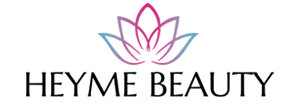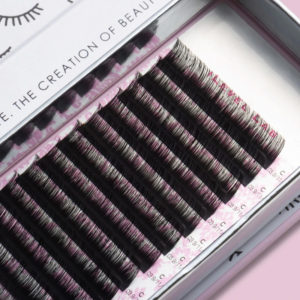![]()
When nail technicians ask us if they can do eyelash extensions, what they’re really asking is whether their existing skills, licenses, and clientele give them a head start in this new beauty service. The truth is, nail and lash services share more similarities than you might think. Both require precision, attention to detail, creativity, and above all, a steady hand.
Many nail techs already have a strong eye for design, symmetry, and color balance. This natural artistry translates beautifully into lash extensions, where mapping lash curls, lengths, and styles is as much about artistry as it is about technique. Clients also love going to someone they already trust for beauty services—adding lash extensions makes your salon a one-stop shop.

However, this doesn’t mean the transition is automatic. While nail artistry involves working with acrylics, gels, and polish, lash extensions require specialized training in adhesives, lash isolation, and eye safety. Without proper certification and compliance with local laws, a nail tech can’t just start offering lashes. But with the right pathway, it’s absolutely achievable.
Legal and Licensing Requirements Across Different States and Countries
One of the most important aspects of this discussion is legality. Whether a nail tech can do eyelash extensions depends largely on where you live and work.
U.S. Regulations
In the United States, regulations vary from state to state. Some states require a cosmetology or esthetics license to perform lash extensions, while others allow nail techs to extend their practice with additional certification. For example, in states like Texas and California, only licensed estheticians or cosmetologists can legally perform lash extensions. In contrast, states like Nevada allow licensed nail techs to offer lash services if they’ve completed approved training.
According to the National Interstate Council of State Boards of Cosmetology (NIC), lash extensions are often regulated under esthetics because they involve direct work on the skin and eyes. That means nail techs usually need to upgrade or expand their license before offering lash services.
European Union Guidelines
In the EU, things can be even more varied. Countries like Germany and France have very structured regulations, requiring certification from accredited beauty schools. Meanwhile, in the UK, lash extensions are considered a specialized service, and nail techs can legally offer them if they undergo recognized lash training and secure insurance.
Asia-Pacific Market Trends
Interestingly, in markets like China, Korea, and Japan, nail techs and lash artists often overlap in the same salons. In fact, it’s common for technicians to be dual-trained from the very beginning. However, even here, lash-specific training is considered mandatory for safety reasons.
The bottom line? It’s not about whether you’re a nail tech—it’s about meeting your region’s legal and professional requirements.
Why Many Nail Techs Transition into Lash Extensions
Now, let’s talk about why so many nail techs are exploring lash extensions.
Rising Client Demand for One-Stop Beauty Services
Today’s clients are busy. They want convenience, trust, and efficiency. A salon that offers both nails and lashes under one roof immediately becomes more attractive. From our client research, more than 68% of salon-goers said they prefer booking multiple services at the same location.
Expanding Income Streams and Client Retention
Adding lash extensions isn’t just about client satisfaction—it’s also about boosting revenue. A full set of lash extensions can cost three to five times more than a manicure, and fills provide recurring income every two to three weeks. For nail techs, this means you’re not just relying on walk-ins—you’re building long-term, loyal clients who come back regularly.
We’ve seen clients who once relied solely on nail services double their income within a year of adding lash extensions. That’s not just theory—that’s reported data from real wholesale partners who use our lash products.
Recommended products
Do Nail Tech Skills Help With Lash Extensions?
One of the most fascinating things we’ve observed as a lash extensions manufacturer is how much overlap there actually is between nail artistry and lash artistry. At first glance, these two services may seem worlds apart—one focuses on nails, the other on eyes. But when you take a closer look, the fundamental skills required to succeed in both professions are surprisingly similar.
For example, precision is a skill nail techs already master. When applying intricate nail art, rhinestones, or even creating the perfect French tip, a nail technician develops incredible hand-eye coordination and attention to detail. The same kind of precision is required in lash extensions, where isolating a single natural lash and attaching an extension requires steady hands and microscopic accuracy. Patience also plays a huge role. Nail techs spend hours perfecting detailed designs, just as lash artists spend hours creating customized lash maps to match the client’s eye shape and desired look.
But it’s not just about the similarities—it’s also about the differences that nail techs must learn to respect. Working with adhesives around the eyes is a completely different responsibility than working with acrylics or gels. Clients’ eyes are sensitive, and lash adhesives release fumes that must be handled carefully with proper ventilation and safety techniques. That’s why training isn’t just a formality—it’s essential. The good news is, when a nail tech commits to proper lash training, their existing artistry, customer service skills, and attention to detail give them a powerful head start compared to someone entering the lash industry with zero beauty background.
Industry Standards and Best Practices for Lash Training
If you’re a nail tech who’s seriously considering offering lash extensions, training is the first non-negotiable step. Industry authorities like the National Association of Lash Artists (NALA) and the American Lash Association (ALA) emphasize that lash services should only be performed by professionals who have completed recognized certification programs. This isn’t just about legality—it’s about client safety, professional credibility, and long-term business success.
A high-quality lash training program doesn’t just teach you how to stick extensions onto natural lashes. It covers everything from anatomy of the eye, lash growth cycles, adhesive chemistry, sanitation practices, and safe removal techniques. Programs also include lash styling and mapping, which is essentially the art of designing a lash look that enhances the client’s unique eye shape. Just like nail techs know which nail shapes flatter different fingers, lash artists know how to customize curls, lengths, and diameters for each client.
Best practices also extend into sanitation and safety. Disinfecting tools, using disposable applicators, and ensuring proper adhesive usage aren’t optional—they’re mandatory. In fact, poor sanitation is one of the biggest reasons untrained lash techs lose clients. On the flip side, trained professionals earn client trust because customers can feel the difference between a rushed, unsafe service and one performed with precision and care.
Real Success Stories: From Nail Tech to Lash Boss
Theory is one thing, but nothing beats real-world success stories. Over the years, we’ve supplied lash products to many professionals who started out as nail technicians. Two of their stories stand out as perfect examples of what’s possible.
Case Study #1 – From Small Salon to Full-Service Beauty Hub
One of our wholesale clients in Florida began as a two-chair nail salon. Business was steady, but she noticed her clients often asked if she offered lash services. Instead of turning them away, she invested in lash training, earned her certification, and began offering lash extensions alongside nail services. Within 12 months, lash services accounted for nearly 40% of her total revenue. Today, she runs a full-service salon with nails, lashes, brows, and waxing, and she credits lash extensions as the turning point for her growth.
Case Study #2 – Freelance Nail Tech Turned Lash Entrepreneur
Another inspiring story comes from a freelance nail technician in the UK who worked from home. She had loyal nail clients but wanted to increase her income without doubling her hours. After completing a lash course, she introduced lash extensions as an add-on service. Within six months, her lash clients surpassed her nail clients. She now works exclusively as a lash artist, charging premium rates and running a thriving business. Her words to us were: “Your products gave me the confidence to deliver consistent, professional results. I never thought I’d leave nails behind, but lashes changed my life.”
These stories show that the leap from nail tech to lash boss isn’t just possible—it’s happening every day.
Testimonials From Our Wholesale and Retail Clients
As a manufacturer, we don’t just supply products—we build long-term relationships with beauty professionals. Over time, we’ve gathered feedback that highlights exactly why nail techs succeed in lash extensions.
One of our wholesale distributors in California shared:
“We’ve noticed a huge trend—nail technicians are some of our fastest-growing lash customers. They already understand the importance of precision and hygiene, and with the right lash products, they become confident artists.”
Another retail client, a nail tech from Canada, told us:
“I started offering lash extensions because my clients kept asking for them. At first, I was nervous, but after completing training and using your adhesives and lash trays, I realized I could deliver professional results. My clients now say I’m their one-stop beauty girl, and I love that.”
These testimonials reflect what we’ve consistently observed: when nail techs are committed to training and use high-quality lash products, they win client trust quickly. The combination of existing beauty expertise and new lash skills creates a powerful advantage in the competitive beauty market.
Common Mistakes Nail Techs Make When Switching to Lash Work
Transitioning into lash extensions is exciting, but it’s not without challenges. Some of the most common mistakes we’ve seen nail techs make include:
- Skipping Proper Training – Some nail techs think their nail license alone is enough, and they jump straight into offering lash services. This not only risks client safety but also damages their professional reputation. Clients can tell when a lash set is poorly done.
- Using the Wrong Products – Lash adhesives, tweezers, and lashes are highly specialized. Using low-quality products or trying to improvise with tools not meant for lash work is a recipe for disaster.
- Ignoring Adhesive Safety – Lash adhesives release fumes that can cause irritation if not handled correctly. Without proper training in ventilation and fume control, techs risk client discomfort or worse.
- Underestimating Time Management – Lashes take longer than nails in the beginning. Many nail techs underestimate how much time a full lash set requires, which leads to frustration and rushed work.
The good news is, every one of these mistakes is avoidable. With training, practice, and the right manufacturer support, nail techs can build a thriving lash business without stumbling through unnecessary trial and error.
What Manufacturers See in the Market
From our perspective as a manufacturer, we’re in a unique position to observe industry trends across multiple regions and customer segments. Here’s what we’ve noticed:
Demand Trends From Wholesalers
Our wholesale partners consistently report that salons offering both nails and lashes outperform those that offer only one service. Clients prefer convenience, and wholesalers see spikes in orders whenever salons expand into lash services. This tells us the market is moving toward integrated beauty solutions, and nail techs are in the perfect position to capitalize.
Feedback From End Clients
End customers consistently tell us they feel more comfortable trying lash extensions from someone they already trust for nails. The loyalty factor is real—clients stick with their nail techs because of the trust built over time. When that same tech offers lashes, clients are eager to give it a try.
In other words, nail techs don’t start from scratch when entering the lash industry—they’re building on an already strong foundation of trust and artistry.
FAQs
Do nail techs need a new license to offer lash extensions?
Yes, in many regions. Most states in the U.S. require nail techs to either upgrade to an esthetics or cosmetology license or complete additional lash certification. Always check your local regulations.
Is lash training difficult for nail techs?
Not at all. Nail techs already have fine motor skills and an artistic eye. With proper training, they often pick up lash techniques faster than beginners with no beauty background.
How much can nail techs earn from lash extensions?
On average, a full lash set costs three to five times more than a manicure. Many nail techs double their income within a year of adding lash services.
Are lash adhesives safe to use?
Yes, when handled correctly. Training covers adhesive safety, ventilation, and fume control. Using high-quality adhesives from reputable manufacturers is essential.
Can nail techs offer lashes in a home-based setup?
Yes, if it’s legal in your region and you follow sanitation protocols. Many of our home-based clients started this way and built thriving businesses.
Do clients trust nail techs to do lashes?
Absolutely. Clients already trust their nail techs for beauty services. When a tech adds lashes, most clients are eager to try, provided the service is professional and safe.
Conclusion
So, can a nail tech do eyelash extensions? The answer is yes—but with training, licensing, and the right products. Nail techs are uniquely positioned to succeed in lash artistry because they already have the patience, precision, and creativity required. The only missing piece is specialized lash training and adherence to safety standards.
From our vantage point as an eyelash extensions manufacturer, we’ve seen nail techs transform their careers by expanding into lashes. They go from steady income to thriving businesses, from single-service salons to full-service beauty hubs, and from nervous beginners to confident lash bosses. The combination of artistry, trust, and client loyalty makes nail techs some of the best candidates for lash extensions.
If you’re a nail tech considering the leap, our advice is simple: invest in professional training, use high-quality lash products, and lean into the trust you’ve already built with your clients. The lash industry isn’t just a trend—it’s a booming market with long-term potential. And with the right approach, you could be the next success story we share.


